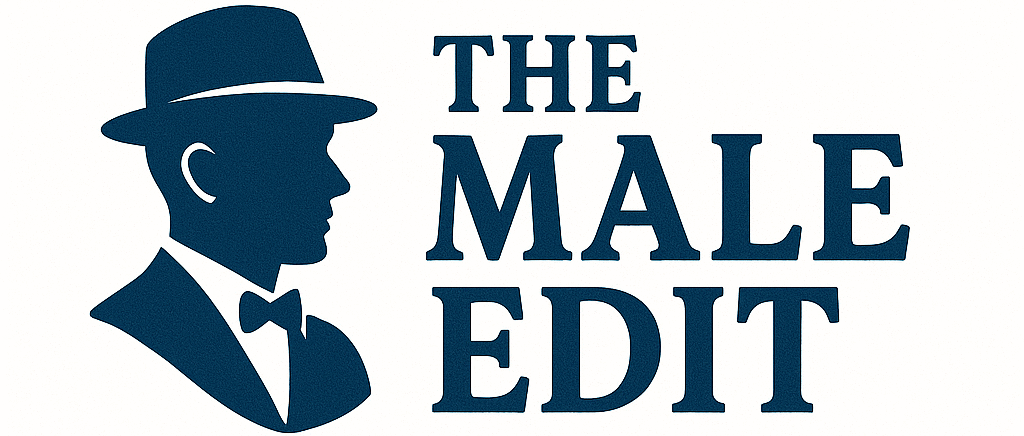The modern mullet has made an incredible comeback and we can’t deny its appeal for men with straight hair. This isn’t your typical 80s throwback – today’s mullet is sleek sophisticated and surprisingly versatile. We’re seeing everyone from celebrities to everyday guys embracing this bold hairstyle that perfectly balances professional and edgy.
What makes the modern mullet particularly stunning on straight hair is how it creates clean lines and sharp contrasts. The shorter front and sides provide that polished look while the longer back adds personality and movement. We’ve discovered that straight-haired men actually have a unique advantage with this cut since their hair naturally showcases the mullet’s distinctive shape without fighting against natural texture.
Whether you’re considering a subtle business mullet or ready to go full rockstar we’ll show you exactly how to make this trend work for your straight hair and lifestyle.
What Is the Modern Mullet for Men With Straight Hair
The modern mullet represents a refined evolution of the classic “business in the front, party in the back” philosophy that dominated the 1980s. We’re witnessing a sophisticated reimagining that transforms this once polarizing style into a versatile haircut suitable for contemporary lifestyles. Today’s version emphasizes clean lines, graduated layers, and strategic length variations that create visual interest without appearing unkempt.
Straight hair provides an ideal foundation for showcasing the modern mullet’s architectural elements. The natural texture allows for precise cutting techniques that highlight the contrast between shorter front sections and longer back portions. We see how the absence of natural curl or wave creates clean definition lines that make the style’s intentional asymmetry more pronounced and visually striking.
Key characteristics of the modern straight hair mullet include:
- Graduated length transitions that blend seamlessly from short to long sections
- Textured top sections ranging from 2 to 4 inches for styling versatility
- Tapered sides that maintain professional appearance while adding contemporary edge
- Controlled back length typically extending 2 to 6 inches past the neckline
- Defined perimeter lines that create sharp visual boundaries between sections
Professional barbers and stylists have developed exact cutting techniques that maximize straight hair’s natural advantages for mullet styling. The hair’s tendency to lay flat creates opportunities for precision cutting that emphasizes geometric shapes and clean separations. We observe how straight hair’s predictable growth patterns allow for more consistent maintenance schedules and styling routines.
Contemporary mullet variations accommodate different lifestyle needs while maintaining the style’s core identity. Business professionals often opt for subtle versions with minimal length difference between front and back sections. Creative professionals and younger demographics frequently choose more dramatic interpretations that feature important length contrasts and bold styling elements.
Why the Modern Mullet Works Perfectly for Straight Hair Types

Straight hair provides an exceptional foundation for modern mullets because of its naturally sleek and manageable texture. We’ve observed that this hair type allows the mullet’s distinctive layers to move freely while maintaining their shape throughout the day, creating the clean lines that define contemporary versions of this classic cut.
Natural Volume and Movement Benefits
Texture advantages become immediately apparent when styling straight hair into a modern mullet. Smooth strands hold their position without excessive product, allowing the voluminous back section to maintain its dramatic effect while the shorter sides remain crisp and defined. We find that straight hair’s ability to showcase geometric shapes makes it ideal for the precise layering techniques that modern mullets require.
Easy Maintenance and Styling Flexibility
Daily styling becomes remarkably simple with straight hair mullets since minimal product is needed to achieve various looks. Running your fingers through the hair creates an effortless tousled effect, while a light hold product delivers a sleeker finish for professional settings. Straight hair responds predictably to styling tools and techniques, ensuring consistent results whether you’re aiming for casual or polished appearances.
Enhanced Facial Structure Definition
Facial features receive maximum enhancement from straight hair mullets because the shortened sides create sharp contrasts without competing textures. Clear sight lines draw attention to bone structure while the longer back and top sections add visual interest and personality. We’ve noticed that straight hair’s smooth surface reflects light more evenly, amplifying the cut’s architectural elements and creating striking silhouettes.
Versatile Customization Options
Personalization opportunities expand significantly with straight hair types since they accept fades, undercuts, and added texture treatments more readily than other hair types. Individual preferences and hair density variations can be accommodated through subtle blending techniques that avoid abrupt transitions. Modern straight hair mullets adapt to various lengths from short to long while maintaining the balance between rebellious flair and contemporary polish that makes this style so appealing in 2025 and 2025.
Classic Modern Mullet: The Business-in-Front, Party-in-Back Style

The classic modern mullet perfectly embodies the timeless “business in the front, party in the back” philosophy while maintaining contemporary sophistication. This distinctive approach creates a striking contrast between the shorter, professional looking front and sides paired with the longer, more expressive back section.
Low-Maintenance Styling Requirements
Straight hair makes the modern mullet surprisingly easy to maintain compared to other textured cuts. We find that this style requires minimal product application, often needing just a small amount of texture paste or light hold gel to enhance the natural flow. Daily styling becomes effortless since straight hair naturally holds the mullet’s shape without extensive manipulation or frequent touch-ups.
Morning routines become streamlined with this cut, as the hair typically falls into place with simple finger combing or a quick brush through. We recommend using a lightweight styling cream to add subtle definition while preserving the hair’s natural movement. Air drying works exceptionally well for straight hair mullets, eliminating the need for extensive blow drying or heat styling tools.
Product versatility allows for different looks depending on the occasion, from a sleek professional appearance using smoothing serum to a more textured, casual style with sea salt spray. We’ve observed that busy professionals particularly appreciate how this cut transitions seamlessly from boardroom meetings to after work social events with minimal styling adjustments.
Best Face Shapes for This Cut
Oval faces work exceptionally well with the modern mullet, as the balanced proportions complement the cut’s natural flow and dimension. We consistently see excellent results with this face shape because the mullet’s structure enhances rather than overwhelms the facial features. Square faces benefit from the softening effect of the longer back section, which helps balance the strong jawline while the shorter front maintains a clean, structured appearance.
Heart shaped faces find particular success with this style, as the wider back section helps balance narrower chin areas while the controlled front length doesn’t add unnecessary width to the forehead region. We recommend avoiding this cut for round faces, since the added volume at the back can emphasize the circular shape rather than creating the desired contrast and definition.
Angular features receive flattering enhancement from the mullet’s geometric lines, while softer facial structures gain definition from the cut’s sharp contrasts. Diamond shaped faces work well with slight modifications to the side length, allowing us to customize the proportions for optimal balance and visual appeal.
Textured Modern Mullet: Adding Volume and Movement to Straight Locks

We’ve perfected techniques that transform naturally flat straight hair into a voluminous, textured modern mullet. This approach creates the signature tousled look while maintaining the mullet’s distinctive structure.
Creating Natural Texture Without Heat Damage
Choppy layering forms the foundation of texture creation for straight hair mullets. We recommend requesting strategic layers throughout the top and back sections to inject natural movement without relying on heat styling tools. Varying lengths create dimension that lifts hair naturally and encourages organic flow patterns.
Point cutting techniques enhance the lived-in aesthetic by cutting into the hair at angles with scissors. This method produces softer, more natural-looking ends that move freely throughout the day. Barbers use this approach to create subtle texture variations that make straight hair appear fuller and more ever-changing.
Graduated length transitions between sections prevent the blocky appearance that straight hair can sometimes create. We focus on blending techniques that maintain the mullet’s signature contrast while ensuring smooth movement from shorter to longer sections. These cutting methods work specifically well with straight hair’s natural tendency to hold its shape.
Regular maintenance scheduling every 4-6 weeks prevents the style from becoming unbalanced or bulky. Consistent trims maintain the textured appearance and keep the mullet’s proportions looking intentional rather than grown out.
Product Recommendations for Enhanced Grip
| Product Type | Primary Benefit | Best For | Application Method |
|---|---|---|---|
| Matte Pomades | Firmer shaping control | Structured styling | Work through damp hair |
| Styling Clays | Reworkable flexible hold | Daily restyling | Apply to dry hair |
| Texturizing Powders | Root volume and oil absorption | Fine or limp hair | Sprinkle at roots |
Matte finish clays provide the ideal balance of hold and flexibility for straight hair mullets. These products offer reworkable control throughout the day without creating stiffness or unnatural shine. We apply them to slightly damp hair for even distribution and maximum grip.
Lightweight pomades work exceptionally well for men who need firmer shaping capabilities while maintaining a natural appearance. Their matte finish prevents the greasy look that can plague straight hair when using heavier products. These pomades hold the mullet’s shape without weighing down naturally fine textures.
Texturizing powders target exact problem areas by adding volume at the roots and improving overall grip for restyling. We recommend applying these products to clean, dry hair before other styling products. They absorb excess oil while creating the foundation for better product adhesion and longer lasting styles.
Application techniques matter as much as product selection for straight hair mullets. Working products through hair in upward motions helps create lift and prevents the flattening that straight hair naturally experiences. Starting with smaller amounts allows for building up texture gradually without overloading the hair.
Fade Mullet: Combining Contemporary Barbering With Retro Vibes
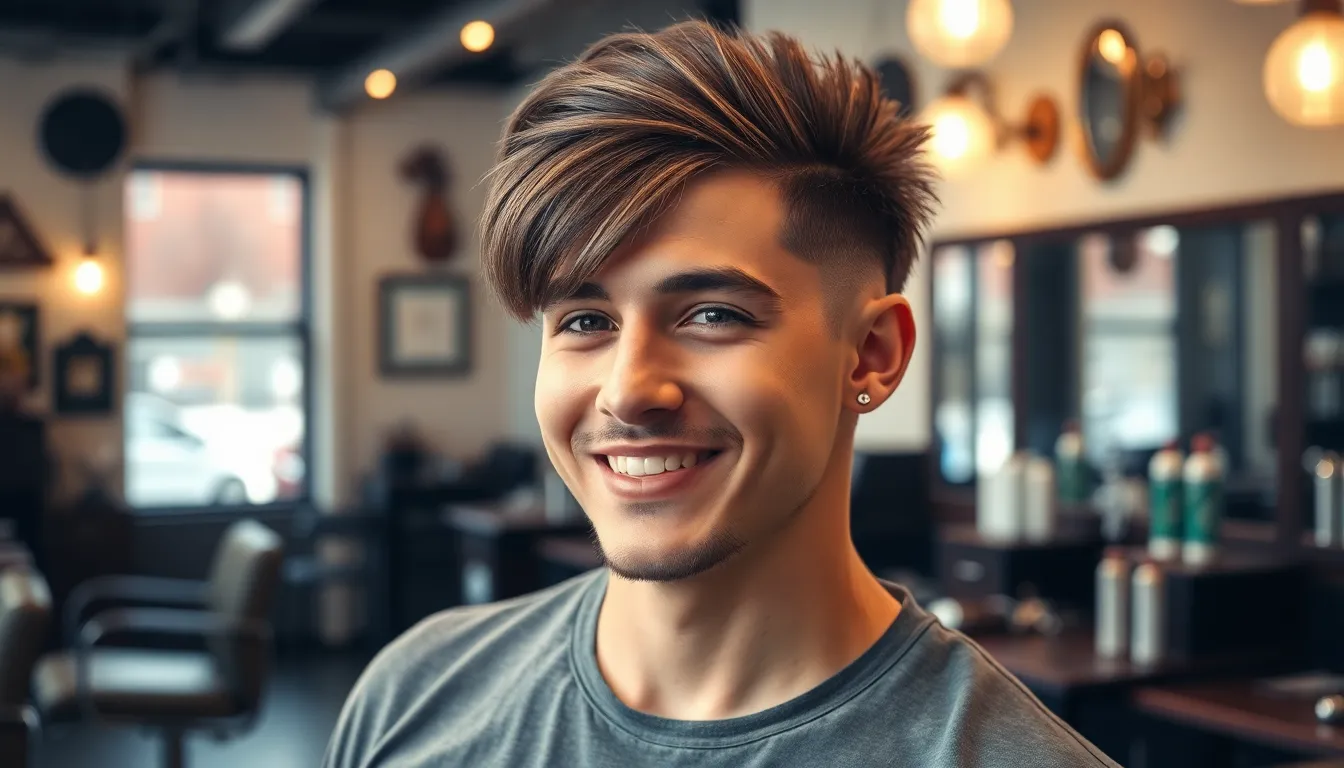
The fade mullet elevates the classic modern mullet by incorporating professional barbering techniques that create seamless transitions from longer sections to cropped sides. Contemporary fade methods blend the iconic mullet structure with graduated tapering, offering men with straight hair a sophisticated approach to this trending style.
High Fade Versus Low Fade Options
High fade mullets start the tapering process near the temples and ears, creating dramatic contrast between the longer crown and back sections. We see this variation highlighting facial features more prominently while emphasizing the mullet’s volume and length at the top. Bold styling choices work exceptionally well with straight hair since the sharp lines create striking geometric shapes that maintain their definition throughout the day.
Low fade mullets begin the gradual tapering lower on the sides, preserving more hair around the ears and creating smoother transitions to longer sections above. We recommend this subtler approach for professional environments or daily wear situations where versatility matters most. Straight hair responds beautifully to low fade techniques because the natural texture allows for seamless blending between different lengths without requiring excessive styling products.
Both fade options offer distinct advantages for straight haired men, with high fades delivering maximum impact and low fades providing balanced sophistication that adapts to various social settings.
Maintenance Schedule and Touch-Up Requirements
Regular touch ups become essential every 2 to 3 weeks to maintain the fade’s crisp definition and prevent new growth from disrupting the style’s sharp lines. We’ve found that straight hair shows fade imperfections more readily than textured hair types, making consistent professional maintenance crucial for keeping the look polished.
Home care routines should include volumizing shampoos that prevent straight hair from falling flat against the scalp. We suggest using lightweight texturizing products like pomades or styling sprays to maintain the layered appearance without weighing down the hair’s natural movement. Quick trimming of fringe areas and mullet ends can be handled at home using quality trimmers, but major reshaping requires professional expertise.
Professional reshaping appointments ensure the fade remains clean and the mullet’s proportions stay balanced as hair grows. We recommend scheduling these sessions with experienced barbers who understand how straight hair behaves during the growing out process, particularly around the fade transition zones where precise cutting techniques make the difference between a sharp style and an unkempt appearance.
Shag Mullet: The Layered Approach for Straight Hair Volume

Shag mullets transform traditional mullet styling by incorporating strategic layers that create exceptional volume and movement for straight hair. This contemporary approach maximizes your hair’s natural texture while maintaining the classic mullet silhouette.
Strategic Layer Placement Techniques
Crown layering forms the foundation of effective shag mullet styling, beginning at the top to create essential lift that prevents the flatness commonly experienced with straight hair. We recommend starting these layers at the crown and working downward to establish natural volume that holds throughout the day.
Graduated back sections receive careful tapering to seamlessly blend longer lengths with the shorter sides and top portions. These layers add crucial movement while maintaining the signature mullet shape, ensuring your style looks intentional rather than uneven.
Textured side layers work in harmony with low or mid fades, though shag variations maintain slightly more texture to enhance the overall tousled appearance. This technique prevents harsh lines while contributing to the modern, effortless aesthetic.
Point cutting techniques break up heavy lines and create natural separation between sections, preventing the blunt appearance that can make straight hair look flat. Razor cutting adds additional texture by creating subtle variations in strand length.
Styling Methods for Maximum Impact
Round brush blow drying becomes essential for boosting volume at the roots while encouraging individual layers to separate and maintain their shape. This foundational technique works particularly well with straight hair’s natural tendency to hold structure.
Matte texture products including sea salt sprays and styling powders help separate strands while improving the layered effect without creating greasiness. We suggest applying these products to damp hair for optimal distribution and hold.
Finger tousling at the crown and back sections creates the signature messy, lived in look that defines modern shag mullets. This technique works best when combined with lightweight texture products that won’t weigh your hair down.
Light hold hairspray maintains your desired shape throughout the day, preventing straight hair from falling flat while preserving the natural movement that makes shag mullets so appealing. Apply sparingly to avoid stiffness that contradicts the style’s effortless appearance.
How to Ask Your Barber for the Perfect Modern Mullet Cut
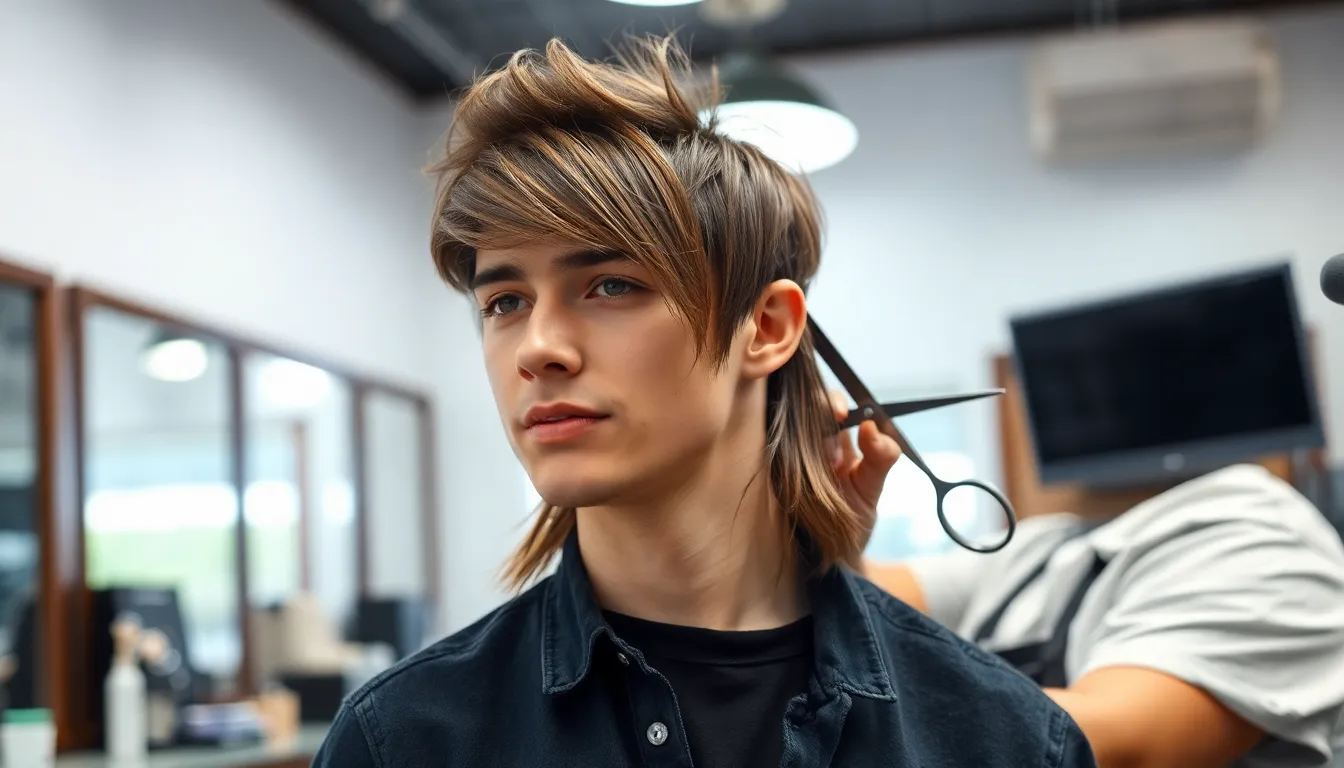
Getting the perfect modern mullet for straight hair starts with clear communication and proper preparation. We’ll show you exactly how to convey your vision to ensure you walk out with the cut you want.
Essential Communication Tips and Reference Photos
Bring visual examples from Pinterest or TikTok to show your barber exactly what you’re envisioning for your modern mullet. Photos eliminate guesswork and help your barber understand the exact proportions you want for your straight hair type.
Use exact terminology when describing your desired cut instead of generic phrases. Request a “modern mullet with tapered sides and longer back” or ask for a “straight bang mullet with medium top length and clean fade” to communicate your preferences clearly.
Describe your lifestyle needs so your barber can adjust the cut accordingly. Mention if you need a more professional version for work or if you want a bolder statement piece for your personal style.
Point out personalized elements you’d like incorporated into the design. Tell your barber if you want a straight line fringe, exact fade intensity, or particular texture additions that match your hair’s natural characteristics.
Discuss maintenance expectations upfront to ensure the cut fits your routine. Let your barber know how often you’re willing to come in for touch ups and how much daily styling time you want to invest.
Questions to Ask Before the Cut
How will you shape the sides and back for my straight hair type? Understanding your barber’s approach helps ensure they’ll work with your hair’s natural texture rather than against it.
What length should I request for the top and back to achieve a modern mullet look? Getting exact measurements prevents miscommunication about proportions and helps create the right balance for your face shape.
Can you add texture or layers to enhance movement? This question opens discussion about techniques like point cutting or choppy layering that can add dimension to straight hair without creating bulk.
What styling products do you recommend for maintaining volume and sharpness in straight hair? Your barber’s product suggestions will be customized to your exact cut and hair type, ensuring you can recreate the look at home.
How often should I schedule trims to keep the style fresh? Regular maintenance timing varies based on how quickly your hair grows and how sharp you want the lines to remain.
| Feature | Description |
|---|---|
| Sides | Shorter, tapered, or faded |
| Top | Medium to long with some length for flow |
| Back | Long, cascading, or layered |
| Fringe | Straight cut bang (optional) |
| Texture | Added layers for movement (optional) |
Daily Styling Routine for Your Modern Mullet With Straight Hair

Creating a consistent daily routine helps maintain your modern mullet’s distinctive shape and professional appearance. We’ll guide you through the essential morning and evening steps that keep your straight hair looking sharp and healthy.
Morning Preparation and Product Application
Start with clean, towel dried hair using a gentle shampoo and conditioner designed for straight hair textures. Fresh hair provides the best foundation for styling products to adhere properly without buildup from previous days.
Apply a lightweight styling clay containing natural ingredients like organic aloe vera and vitamin E to add texture without weighing down your straight strands. We recommend compound clays with French Kaolinite Clay and jojoba oil for their ability to create controlled messiness while nourishing your hair.
Direct your hair backward and to the sides using a blow dryer to emphasize the modern mullet’s characteristic tapered sides and longer back length. Alternatively, let your hair air dry with a diffuser for softer texture while maintaining the controlled yet relaxed appearance that defines contemporary mullet styling.
Focus on the mid lengths and ends when applying your final styling clay application to create definition and subtle texture. This technique enhances the separation between shorter sides and longer back sections that makes your modern mullet distinctive and polished.
Evening Maintenance and Protection
Gently detangle your mullet using your fingers or a wide tooth comb before bedtime to prevent knots from forming overnight. We pay special attention to the longer back sections where tangles typically develop during sleep.
Apply a lightweight leave in conditioner or hair oil specifically formulated for straight hair to nourish strands overnight. Concentrate the product on mid lengths to ends while avoiding the roots to prevent morning greasiness that can weigh down your style.
Protect your style during sleep by loosely securing the longer back section or switching to a silk or satin pillowcase that reduces friction. These materials prevent frizz and breakage that can disrupt your mullet’s clean lines and geometric shape.
Avoid heavy product buildup at night to maintain scalp health and ensure your hair doesn’t become weighed down for the next day’s styling session. Clean hair responds better to morning styling products and maintains the natural movement that makes straight hair mullets so appealing.
Common Mistakes to Avoid With Modern Mullets on Straight Hair

Even the most stylish modern mullet can fall flat if you make these critical errors. Let’s explore the most common pitfalls that can transform your sleek straight hair mullet from sophisticated to sloppy.
Overcutting the Front Section
Removing too much length from the top disrupts the essential “business in the front, party in the back” balance that defines the modern mullet. We’ve seen countless clients who asked for too much off the front, only to end up with an unbalanced cut that looks more like a standard short haircut than a mullet.
Maintaining sufficient length on top creates the texture and flow your straight hair needs to showcase the mullet’s architectural elements. The front section should retain enough length to blend seamlessly into the longer back while still providing contrast with the shorter sides.
Preserving the mullet’s distinctive silhouette requires careful attention to how much length you remove from the crown and front areas. Too aggressive a cut in these zones eliminates the style’s signature proportions and makes it appear overly conservative.
Neglecting Regular Trims and Shape-Ups
Skipping maintenance appointments causes your mullet to lose its defined shape and transforms your intentional style into an unkempt mess. Straight hair shows growth patterns more obviously than textured hair, making regular upkeep essential for maintaining clean lines.
Scheduling trims every 4 to 6 weeks prevents the back from becoming shaggy and ensures your mullet retains its sharp, contemporary appearance. The precision that makes modern mullets work on straight hair disappears when you let the cut grow out without professional attention.
Regular shape-ups keep the contrast between sections crisp and prevent your mullet from looking accidentally grown out rather than purposefully styled. We recommend booking your next appointment before leaving the barbershop to maintain consistency in your mullet’s appearance.
Celebrity Inspiration: Modern Mullet Icons With Straight Hair
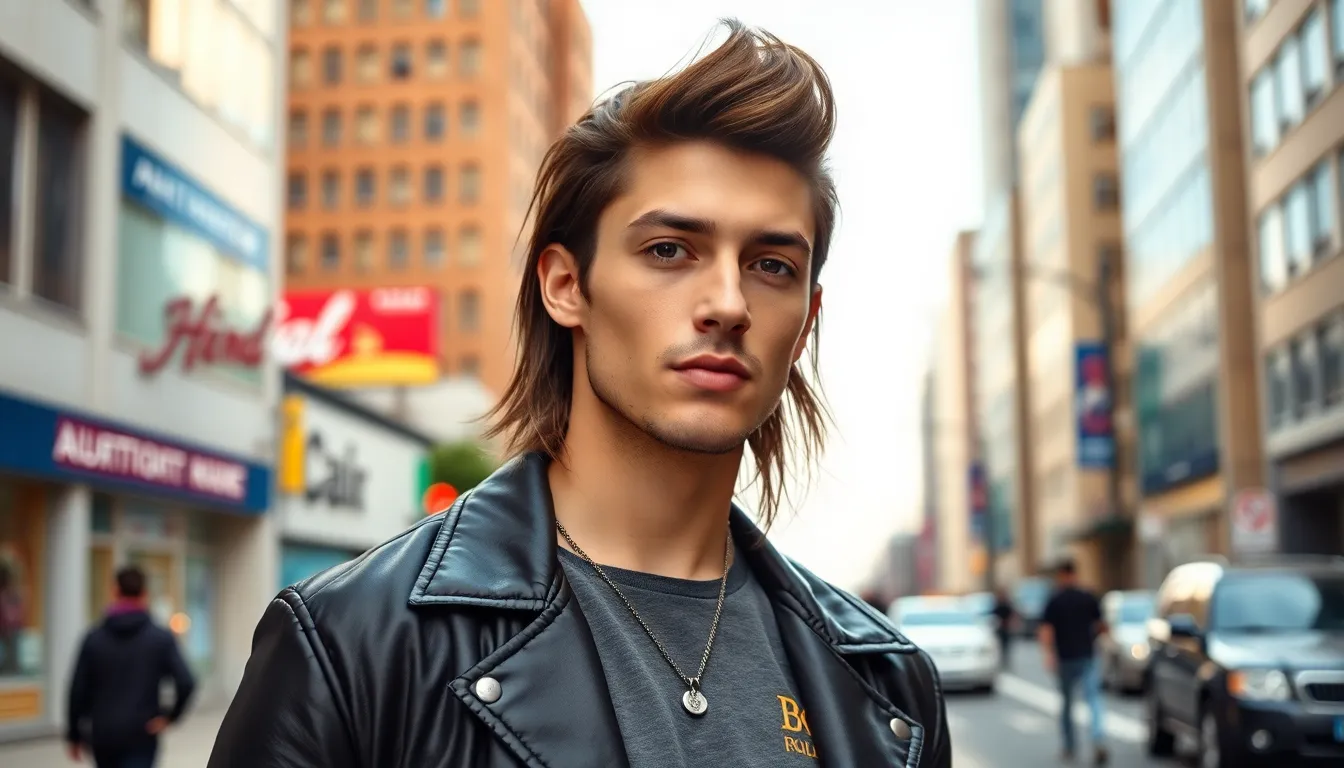
We’re witnessing a remarkable shift in Hollywood as leading men embrace the modern mullet’s sophisticated edge. This contemporary take on the classic cut has gained serious traction among celebrities with straight hair who want to make a bold statement.
Hollywood Stars Leading the Trend
Leading men across Hollywood are choosing the modern mullet as their signature look, showcasing its refined versatility on red carpets and in media appearances. The voluminous top and textured layers create a striking contrast with clean faded sides, allowing straight-haired actors to achieve an edgy yet polished aesthetic that photographs beautifully under studio lights.
Musicians have particularly embraced this trend, using the modern mullet’s structured design to reinforce their artistic personas. The sleek texture of straight hair amplifies the cut’s architectural elements, creating sharp sight lines that enhance facial features during performances and interviews.
Fashion-forward actors are demonstrating how the modern mullet translates seamlessly from casual settings to formal events. Their stylists emphasize the balance between edge and sophistication, proving that this cut works as effectively for award ceremonies as it does for everyday appearances.
Social Media Influencers Making Waves
Male influencers on TikTok and Instagram are amplifying the modern mullet trend through viral styling videos and transformation posts. These content creators with straight hair showcase the cut’s versatility by demonstrating various styling techniques that maintain the mullet’s signature look while keeping it sleek and contemporary.
Styling tutorials from these influencers reveal the secrets behind achieving the perfect volume and texture without heat damage. They’re using subtle texturizing techniques and strategic product application to add movement and definition to their straight locks, inspiring millions of followers to experiment with the cut.
Platform-exact content shows influencers adapting their modern mullets for different occasions, from casual daily wear to special events. Their authentic styling approaches prove that straight-haired men can maintain this trend with minimal effort while achieving maximum impact.
Viral before-and-after transformations continue to drive interest in the modern mullet, with influencers documenting their journey from traditional cuts to this bold new style. These real-time progressions help followers understand the commitment and maintenance required while showcasing the dramatic results possible with straight hair textures.
Professional Versus DIY: When to Visit the Barber
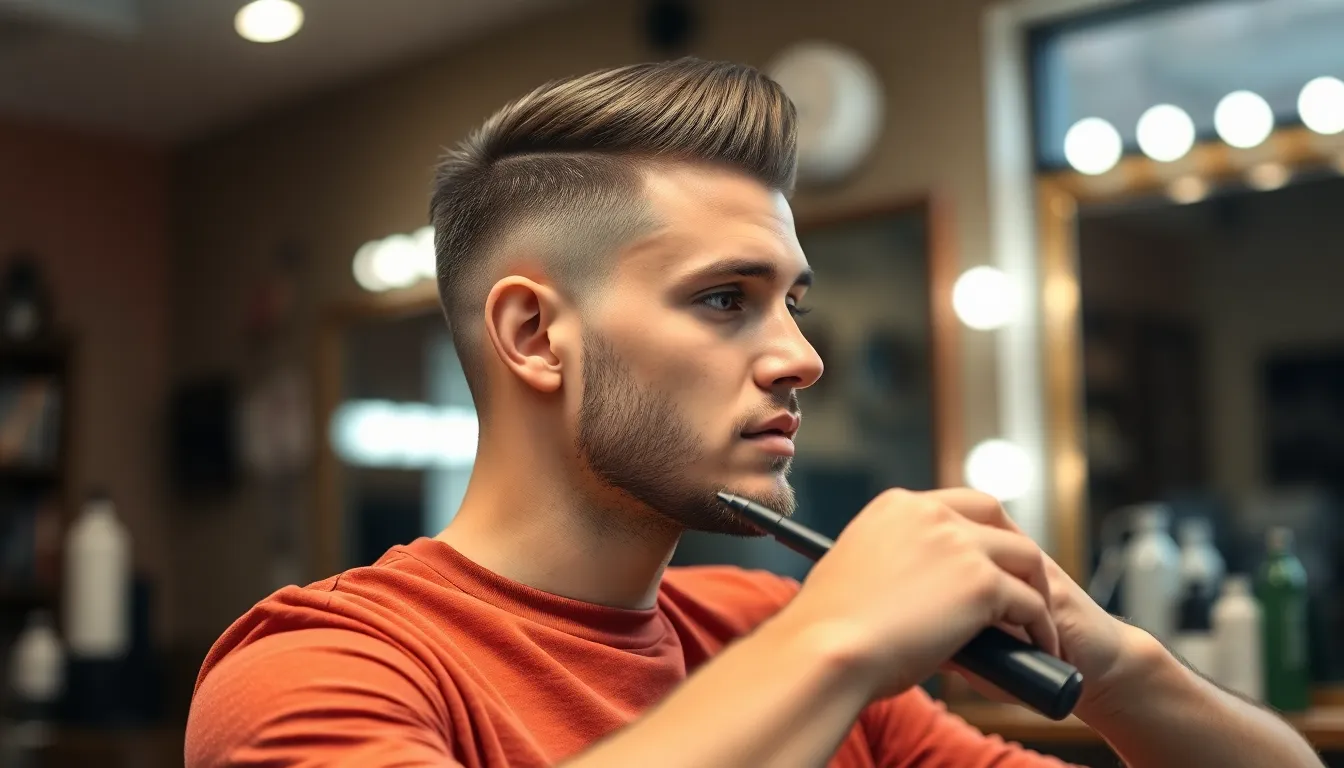
Deciding between professional barber services and DIY maintenance depends on your skill level and the complexity of your desired modern mullet. Professional barbers bring expertise in executing precise fades, delicate blending, and expert shaping that’s particularly crucial for straight-haired mullets where uneven lines become more visible.
Signs You Need Professional Help
Noticeable mistakes or unevenness in your current cut signal it’s time to visit a professional barber. We’ve all been there—what started as a simple trim becomes a lopsided disaster that requires expert correction.
Difficulty blending fades or tapering the sides indicates you need professional assistance, especially since modern mullets rely on seamless transitions. Barbers possess the specialized tools and techniques to create those smooth gradients that make straight hair mullets look polished rather than choppy.
Concerns about hair thinning or irregular hairlines require professional assessment and treatment. Experienced barbers can work around these challenges by adjusting the cut’s proportions and using strategic layering to maximize your hair’s natural advantages.
Desire for a dramatic restyle or new fade means professional help is essential for achieving your vision safely. Major changes in length, adding complex fades, or switching mullet variations demand precision that comes from years of training and practice.
Lack of confidence or experience with hair clippers automatically puts you in the professional help category. We recommend building your skills gradually with minor touch-ups before attempting any important styling changes.
Simple At-Home Touch-Up Techniques
Trimming split ends at the back works well for maintaining your mullet’s length between barber visits. Use sharp hair scissors to carefully cut damaged ends, blending them into the existing length without creating harsh lines.
Touching up the sides with a beard or hair clipper using larger guards helps maintain your fade’s general shape. Avoid close fading unless you’ve practiced extensively, as mistakes on straight hair become immediately obvious.
Applying matte pomade, styling clay, or texturizing powder enhances your mullet’s definition and provides all-day hold. These products work particularly well on straight hair because they add grip and texture without weighing down your natural movement.
Using a blow dryer strategically creates volume and enhances your straight hair’s natural flow when combined with styling products. Focus the airflow from roots to ends, lifting sections as you dry to maintain the mullet’s distinctive shape and prevent flattening.
Conclusion
The modern mullet for straight hair represents more than just a trending haircut—it’s a versatile style statement that bridges classic rebellion with contemporary sophistication. We’ve explored how straight hair’s natural advantages make this cut particularly striking with its clean lines and architectural precision.
From textured variations to fade combinations the modern mullet offers countless customization options for every lifestyle and preference. Whether you’re drawn to the subtle business-friendly version or the bold statement style the key lies in proper execution and consistent maintenance.
With celebrity influence driving its popularity and social media showcasing endless styling possibilities the modern mullet isn’t going anywhere. For straight-haired men ready to embrace this trend we recommend consulting with an experienced barber who understands the nuances of creating that perfect balance between edgy and refined.
Frequently Asked Questions
What makes the modern mullet different from the traditional 80s version?
The modern mullet is a refined evolution of the classic style, featuring sleek lines, graduated length transitions, and sophisticated texturing. Unlike the dramatic 80s version, today’s mullet offers subtle variations suitable for professional settings while maintaining the signature “business in the front, party in the back” philosophy with contemporary polish.
Why does the modern mullet work particularly well for straight hair?
Straight hair naturally showcases the mullet’s distinctive shape with clean lines and sharp contrasts. The sleek texture maintains its form throughout the day without excessive product, allows for easy styling, and amplifies the cut’s architectural elements. Straight hair also holds layers better and creates natural volume and movement.
How often should I get my modern mullet trimmed?
Regular maintenance every 4-6 weeks is recommended to keep the style balanced and intentional. For fade mullets, touch-ups every 2-3 weeks are necessary to maintain sharp fade lines. This schedule ensures the cut retains its modern appearance and prevents it from looking unkempt or losing its distinctive shape.
What products work best for styling a modern mullet on straight hair?
Matte pomades, styling clays, and texturizing powders work best for straight hair mullets. These products enhance grip and texture without weighing down the hair. Lightweight styling products help create lift and prevent flattening while maintaining the cut’s clean lines and architectural elements throughout the day.
How do I ask my barber for the perfect modern mullet cut?
Bring visual examples from Pinterest or TikTok and use specific terminology to describe desired features. Discuss your lifestyle needs, ask about shaping techniques, length preferences, texture options, product recommendations, and maintenance schedules. Clear communication ensures your barber understands your vision and can tailor the cut accordingly.
What’s the difference between a high fade and low fade mullet?
High fade mullets create dramatic contrasts with hair cut very short on the sides, offering a bold, contemporary look. Low fade mullets provide a subtler, more professional appearance with a gradual transition. The choice depends on your style preference and workplace requirements.
What are common mistakes to avoid with a modern mullet?
Avoid overcutting the front section, which disrupts the mullet’s balance, and neglecting regular trims, which leads to an unkempt appearance. Don’t cut the top too short, as sufficient length is needed for texture and flow. Also, avoid skipping regular shape-ups that keep the style intentional and sharp.
Can I maintain my modern mullet at home?
Simple at-home maintenance includes trimming split ends and enhancing definition with styling products. However, seek professional help for noticeable mistakes, difficulty blending fades, or dramatic restyles. Professional barbers have the expertise to maintain the cut’s precise lines and proportions that define the modern mullet.
